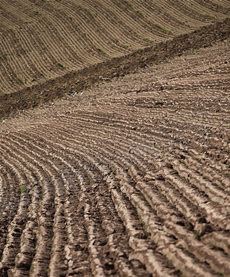Agriculture
Agronomy is a group of applied science disciplines concerned with land and soil management and crop production. Agronomists? areas of interest range from soil chemistry to soil-plant relationships to land reclamation.
The word "agronomy" derives from the ancient Greek agros (field) and nemein (manage) and therefore literally means "field management". The American Society of Agronomy defines agronomy as "the theory and practice of crop production and soil management". There are many specialties within the study of agronomy.
Agronomic Specialties
Agronomy is the family of disciplines investigating the production of crops supplying food, forage, and fiber for human and animal use. It studies the stewardship of the soil upon which those crops are grown. Agronomy covers all aspects of the agricultural environment, from agroclimatology to soil-plant relationships.
It includes crop science, soil science, weed science, and biometry (the statistics of living things) as well as crop, soil, pasture, and range management; turfgrass; agronomic modeling; and crop, forage, and pasture production andutilization.
Within each area are subdisciplines. For example, within soil science are traditional disciplines such as soil fertility, soil chemistry, soil physics, soil microbiology, soil taxonomy and classification, and pedogenesis, the science of how soils form.
Newer disciplines within soil science include such studies as bioremediation, or the study of how living organisms can be used to clean up toxic wastes in the environment, and land reclamation, the study of how to reconstruct landscapes disturbed by human activities, such as surface mining.
Scientific Goals
Chief among detrimental human activities is poor field management, which leads to reduced productivity and reduced environmental quality. Historical examples abound; one is that of the 1930?s Dust Bowl in the United States.
In the early 1900?s much of the American Southern Plains, which had been natural grassland, was converted to wheatland. Planting and plowing methods of the time did not enable wheat to protect the ground against winds. Additionally, overgrazing of livestock had destroyed what grassland remained by the 1930?s.
The soil eroded, drought conditions which would last for most of the decade set in, and a series of wind and dust storms whipped through the region. An estimated 50 million acres of land were destroyed before soil conservation measures, implemented under the administration of Franklin Roosevelt, began to improve the situation.
It is the role of agronomy tomanage soil and crop resources as effectively as possible so that the twin goals of productivity and environmental quality are preserved.
Agronomy treats the agricultural environment as humankind?s greatest natural resource: It is the source of food, clothing, and building materials. The agricultural environment purifies the air humans and other animals breathe and the water they drink.
Agronomists, whatever their specific field, seek to utilize soil and plant resources to benefit society. Crop breeders, for example, use the genetic diversity of wild varieties of domesticated plants to obtain the information needed to breed plants for greater productivity or pest resistance.
Soil scientists study landscapes to determine how best to manage soil resources. Integrating agricultural practices with the environment maintains soil fertility and keeps soil in place so that erosion does not reduce the quality of the surrounding environment.
- New Soil Testing Kit (soildoc) Has Developed For Third World Countries
New soil testing kit has developed by researchers of Columbia University and University of Maryland. The name of this soil testing kit is SoilDoc. This New soil testing kit is developed for farmers in third world countries. This kit has designed...
- Soil Management
Soil ManagementTillage, conservation, and cropping practices are soil management techniques that are used to preserve soil resources while optimizing soil use. Soils aremanaged differently depending on their intended use. Soil management groups are soil...
- Basic Concepts In Crop Production
AGRONOMY Scientific crop production is called Agronomy. CROP Community of plants to produce yield, which are economically important, called Crop. OBJECTIVES OF CROP To provide the food to the human beings and also useful to animals. GENOTYPE Genotype...
- Earthworms Can Survive And Recover After 3-week Drought Stress
Earthworms are a welcomed sight in many gardens and yards since they can improve soil structure and mixing. But they are hard to find in the drier soils of eastern Colorado where water and organic matter is limited. Adding earthworms to fields where they...
- Nitrogen Fertilizers Used Off-season Help Crops Planted Later
Nitrogen Fertilizers Used Off-Season Help Crops Planted LaterOct. 7, 2008 ? Combating soil erosion is a primary concern for agricultural producers in the United States, and many have incorporated conservation tillage systems in their effort to maintain...
Agriculture
Agronomy
 |
| Agronomy |
The word "agronomy" derives from the ancient Greek agros (field) and nemein (manage) and therefore literally means "field management". The American Society of Agronomy defines agronomy as "the theory and practice of crop production and soil management". There are many specialties within the study of agronomy.
Agronomic Specialties
Agronomy is the family of disciplines investigating the production of crops supplying food, forage, and fiber for human and animal use. It studies the stewardship of the soil upon which those crops are grown. Agronomy covers all aspects of the agricultural environment, from agroclimatology to soil-plant relationships.
It includes crop science, soil science, weed science, and biometry (the statistics of living things) as well as crop, soil, pasture, and range management; turfgrass; agronomic modeling; and crop, forage, and pasture production andutilization.
Within each area are subdisciplines. For example, within soil science are traditional disciplines such as soil fertility, soil chemistry, soil physics, soil microbiology, soil taxonomy and classification, and pedogenesis, the science of how soils form.
Newer disciplines within soil science include such studies as bioremediation, or the study of how living organisms can be used to clean up toxic wastes in the environment, and land reclamation, the study of how to reconstruct landscapes disturbed by human activities, such as surface mining.
Scientific Goals
 |
| How to grow juicy tasty tomatoes |
In the early 1900?s much of the American Southern Plains, which had been natural grassland, was converted to wheatland. Planting and plowing methods of the time did not enable wheat to protect the ground against winds. Additionally, overgrazing of livestock had destroyed what grassland remained by the 1930?s.
The soil eroded, drought conditions which would last for most of the decade set in, and a series of wind and dust storms whipped through the region. An estimated 50 million acres of land were destroyed before soil conservation measures, implemented under the administration of Franklin Roosevelt, began to improve the situation.
It is the role of agronomy tomanage soil and crop resources as effectively as possible so that the twin goals of productivity and environmental quality are preserved.
Agronomy treats the agricultural environment as humankind?s greatest natural resource: It is the source of food, clothing, and building materials. The agricultural environment purifies the air humans and other animals breathe and the water they drink.
 |
| Scientific Goals |
Agronomists, whatever their specific field, seek to utilize soil and plant resources to benefit society. Crop breeders, for example, use the genetic diversity of wild varieties of domesticated plants to obtain the information needed to breed plants for greater productivity or pest resistance.
Soil scientists study landscapes to determine how best to manage soil resources. Integrating agricultural practices with the environment maintains soil fertility and keeps soil in place so that erosion does not reduce the quality of the surrounding environment.
- New Soil Testing Kit (soildoc) Has Developed For Third World Countries
New soil testing kit has developed by researchers of Columbia University and University of Maryland. The name of this soil testing kit is SoilDoc. This New soil testing kit is developed for farmers in third world countries. This kit has designed...
- Soil Management
Soil ManagementTillage, conservation, and cropping practices are soil management techniques that are used to preserve soil resources while optimizing soil use. Soils aremanaged differently depending on their intended use. Soil management groups are soil...
- Basic Concepts In Crop Production
AGRONOMY Scientific crop production is called Agronomy. CROP Community of plants to produce yield, which are economically important, called Crop. OBJECTIVES OF CROP To provide the food to the human beings and also useful to animals. GENOTYPE Genotype...
- Earthworms Can Survive And Recover After 3-week Drought Stress
Earthworms are a welcomed sight in many gardens and yards since they can improve soil structure and mixing. But they are hard to find in the drier soils of eastern Colorado where water and organic matter is limited. Adding earthworms to fields where they...
- Nitrogen Fertilizers Used Off-season Help Crops Planted Later
Nitrogen Fertilizers Used Off-Season Help Crops Planted LaterOct. 7, 2008 ? Combating soil erosion is a primary concern for agricultural producers in the United States, and many have incorporated conservation tillage systems in their effort to maintain...
